- Testing Basics
- Home
- /
- Learning Hub
- /
- Static Testing Tutorial
- -
- September 27 2023
What Is Static Testing: Its Features And Best Practices
Static testing, a non-execution method, reviews code for errors, enhancing quality and preventing issues before execution.
OVERVIEW
Static testing is a software testing method that aims to identify defects in software applications without the need to execute the actual code. This method contributes to the seamless and trouble-free progression of the software development process, which involves a comprehensive examination of software documentation, code, and functional specifications.
To achieve a high level of software quality, it is crucial to thoroughly test the software application before it is delivered to customers. There are different methods available for verifying a developed software. It is more efficient to prevent defects in the early phases rather than dealing with them after they have already become intricate issues. Static testing is carried out in the early stages of development to proactively identify and avoid defects.
This guide delves into the comprehensive understanding of static testing, including its underlying principles, procedural aspects, associated techniques, advantages, and tools designed specifically for testing. Let's delve into the intricacies of static testing and gain a deeper understanding.
What is Static Testing?
Static testing involves verifying and validating the software applications without executing the code and test cases. Rather, it includes code examination and reviewing appropriate documents without executing the program.
It primarily involves visual inspection and code validation to ensure thorough functional coverage. This analysis encompasses tasks such as pinpointing errors, identifying unused code segments or variables, and confirming compliance with coding standards, among other considerations. It excels in detecting errors that dynamic testing might overlook.
This aims to uncover issues early in software development when rectification is simpler and less costly. This early detection significantly uplifts overall software quality and dependability; hence, it is also known as the verification process.
Furthermore, it enhances the ease of maintenance, ultimately resulting in long-term time and cost efficiencies. This is primarily achieved through various methods such as reviews, inspections, analysis, and walkthroughs, which facilitate the identification of bugs or errors without the need to execute the application. However, comprehensive documentation containing all the relevant details is necessary for these processes.
Requisite documents for the testing process:
- Business requirement documents and customer requirement specifications.
- Functional requirement documents and Software requirement specifications(SRS).
- User stories and Use case documents.
- Prototypes and design specification documents.
- High-level and low-level design documents.
- Testing documents encompass test plans, strategy documents, test scenarios, test cases, test data, and requirements traceability matrices.
Here are some key objectives of testing:
- Ensuring adherence to programming conventions, standards, and guidelines.
- Ensuring that the source code is complete and successfully compiles and builds.
- Confirming alignment with all design and implementation specifications.
- Identifying segments within the software that could contain logical, structural, formatting, or syntactic errors.
Features of Static Testing
It is important to understand the key features to clarify the concept of static testing and how to perform it. Here are some of the key features of static testing:
- Reviewing Requirements and Specifications: Analyzing functional and non-functional requirements while assessing their practicality.
- Structural Design Assessment: Evaluating the static structure compared to the system requirements.
- Code Inspection: Manually examining the code for errors and ensuring it adheres to standards.
- Database Scrutiny: Verifying consistency and alignment with the database design.
- Document Review: Evaluating the accuracy and user-friendliness of documentation.
Key Applications of Static Testing
It applies to different scenarios and situations with the common objective of ensuring the quality of the software application. Here are some of its key applications:
- Validation of Unit Test Cases: Early issue identification is the key focus.
- Reviewing Business Requirement Documents: This process helps ensure that requirements align with system needs.
- Considering Use Cases: It extends to scenarios involving use cases.
- Testing Functional Requirements: It effectively pinpoints issues related to functional aspects.
- Assessing Prototypes and Specifications: Testing highlights prototype problems and their specifications.
- Evaluating Data and Traceability Matrices: It highlights test data and traceability concerns.
- Ensuring Effective Training: It contributes to creating accurate training guides.
- Proactive Detection in Automation and Performance Testing: It identifies potential issues ahead of time.
Key Aspects of Static Testing
The core testing components offer insight into code development and comprehension. When starting static testing, these aspects are viewed as extensions that should be ensured through software testing tools.
- Follow the Rules: To ensure all developers are on the same page, it's important to stick to the coding rules. We can use special tools to check if everyone is following these rules. Without these tools, it's harder to ensure everyone is doing things the same way.
- Measure the Code: We can use "code metrics" to measure how our code is structured. As our software gets more complicated, code metrics help us make it work better and give us ideas on organizing it.
- Plan the Code: Before writing the code, we must plan its structure. This includes how the different parts of the program will work together, like loops and conditions. We also want to eliminate any code that's not doing anything useful. This planning helps us make changes to the code more easily later on. We also look at different ways to organize the data in our code, even if it's complicated.
Advantages of Static Testing
The key advantages are as follows:
- Early Issue Detection: It helps identify and resolve issues early.
- Cost and Time Savings: It reduces the need for rework, saving time and money.
- Improved Development Efficiency It streamlines the development process and reduces testing efforts.
- Valuable Feedback: It provides valuable feedback that enhances the software development.
- Team Collaboration: Collaboration among team members fosters a shared understanding of technical details and software requirements, leading to overall higher quality.
Disadvantages of Static Testing
Here are some disadvantages to consider:
- Manual static testing requires a significant investment of time and human resources.
- Automated tools are limited to particular programming languages.
- Automated tools may produce inaccurate results, focusing solely on code scanning and potentially overlooking vulnerabilities.
Static Testing vs. Dynamic Testing
The difference between Static and Dynamic testing lies in their respective approaches to ensuring software quality. Static testing is carried out in the early stages of development to proactively identify and address errors when they are easier to rectify. On the other hand, Dynamic testing evaluates the software's behavior by testing its input and output values, providing insights into its functional performance.
Let’s understand the difference between static and dynamic testing better.
| Static Testing | Dynamic Testing |
|---|---|
| Evaluates documents, plans, requirements, and specifications, as well as source code, to identify gaps or issues. | Tests the product to validate its behavior and functionality as per customer requirements. |
| Conducted as part of the verification process before product or application development. | Conducted as part of the validation process after product development. |
| Performed without executing the actual source code of the application. | Performed after executing the programming code of the application. |
| Correcting issues at the initial stage reduces cost and time. | Correcting issues at this stage may take some time. |
| Techniques include Reviews, Inspections, and Walkthroughs. | Techniques include unit testing, integration testing, system testing, and acceptance testing. |
| Aims to prevent defects. | Aims to detect defects. |
| Quality is achieved through reviews and feedback from multiple experts. | Quality is achieved through rigorous testing performed at various testing levels. |
| Involves multiple individuals, from management to technical teams. | The main participants include the testing and development teams. |
Note : From static testing to dynamic testing, LambdaTest's AI-powered platform has you covered. Discover the future of software testing. Try LambdaTest Now!
What is Tested in Static Testing?
It's common practice to analyze code, design documents, and requirements before running software to detect errors. This approach applies to all components of software applications related to functional requirements, ensuring thorough examination. In particular, this process involves reviewing written materials that provide a comprehensive view of the tested software application.
Numerous elements of the subject are encompassed as follows:
- Requirement analysis
- Design documents
- Page content
- Source code
- Test cases, test data, and test scripts
- BRD (Business Requirements Document)
- Functional/System Requirements
- Unit Use Cases
- Prototype
- Prototype Specification Document
- Database Fields Dictionary Spreadsheet
- Test Cases/Test Plan Strategy Document
- Traceability Matrix Document
- Performance Test Scripts/Automation
When is Static Testing Required?
As highlighted in the previous sections, static evaluation efficiently identifies errors early in the Software Development Life Cycle(SDLC). It is necessary only in its initial phase, preceding the actual testing of software applications. This well-organized approach ensures that potential issues are discovered and addressed before dynamic testing. Here are some critical scenarios when you should perform this type of evaluation.

- Design Phase: The design phase is crucial in identifying errors in the software's architecture, structure, and overall functionality.
- Documentation Phase: The document phase involves the creation of user manuals, technical guides, and project documentation. Here, static examination must be done, which involves carefully reviewing materials for accuracy and completeness.
- Development Phase: In the development phase of software applications, particular attention is given to the source code. Here, you must conduct code reviews, inspections, and analyses to detect coding errors, syntax issues, and other problems.
How to Perform Static Testing?
Now that you are familiar with static testing and its fundamental concept let's delve into the steps required to carry it out.
- Planning: In static testing, the initial step involves planning the test, where the testing teams define the aspects and features of the software application that require assessment. During this phase, they establish the testing objectives, define the test scope, and develop the test strategy. It is essential to identify the software application components to be evaluated and specify the methodology and tools required for testing.
- Artifact Preparation: In the subsequent step, testing teams gather resources such as source codes, design documents, requirements, and test cases. Having these artifacts readily available ensures accurate documentation for the testing process.
- Analysis: This phase forms the core of static testing, involving a thorough review and analysis of the code. Testers assess code compliance with coding standards, code quality, and potential security issues. This analysis can be conducted without executing the code or running the application, with the option to leverage software testing tools, as mentioned earlier.
- Code Review and Walkthrough: Following the analysis, the next step comprises code review and walkthrough, essential activities involving team members. Code review assesses code quality, while walkthroughs help team members become more familiar with the code and identify potential issues.
- Expert Evaluation: In this stage, a panel of testing experts systematically examines the code and other documents, utilizing various techniques to uncover potential errors.
- Issue Reporting: After reviewing critical documents and code, testing experts document and report any identified issues or bugs encountered during the assessment.
- Result Analysis: Lastly, testing teams meticulously analyze the assessment results to evaluate the software application's overall quality.
By following these steps, you can ensure software quality before it’s released to production. Advanced tools, including static code analyzers, lint tools, and various software testing utilities, can facilitate the necessary evaluations.
Why Perform Static Testing?
Static testing involves a comprehensive analysis of software project specifications in the early development phases. This proactive approach helps detect defects early, allowing for timely corrections before they progress to later phases. Addressing issues early significantly reduces overall testing expenses by saving substantial time.
Testing's utility extends to identifying ambiguities in project documentation, clarifying misunderstandings about requirements, and pinpointing flaws in requirements and design elements. The primary focus is on reviewing software requirements.
This process allows for identifying conflicts that can be challenging to resolve later in the development cycle. Similarly, reviewing code during testing can uncover coding errors and inconsistent naming conventions. This method is crucial for enhancing software development efficiency and enables the swift detection and correction of coding errors during the initial stages of a software project.
The benefits of this approach resonate throughout the development process. It speeds up coding efforts by providing clear guidelines, reviews, inspections, and more, all contributing to improved developer productivity. Furthermore, it reduces the prevalence of defects in later testing phases, mitigating potential setbacks.
- Improved Development Productivity: Following established guidelines and methods enables developers to work more efficiently.
- Early Detection and Resolution: Applying static testing, the application helps identify and address defects during their early stages.
- Cost and Time Savings: It leads to reduced testing costs, shorter development cycles, and overall time savings.
This practice aligns to improve development quality while facilitating an environment of efficient and effective software application development.
Note : Boost your software development with LambdaTest! Detect defects early, improve productivity, and save time and costs. Elevate your software quality with LambdaTest. Try LambdaTest Now!
Static Testing Techniques
Use different techniques to identify errors and inconsistencies before deploying applications to the production environment. Knowing those techniques will help you execute testing without missing any crucial aspects in the software testing process. Typically, it involves two significant techniques: review and static analysis.
Let us understand each in detail from the information below.
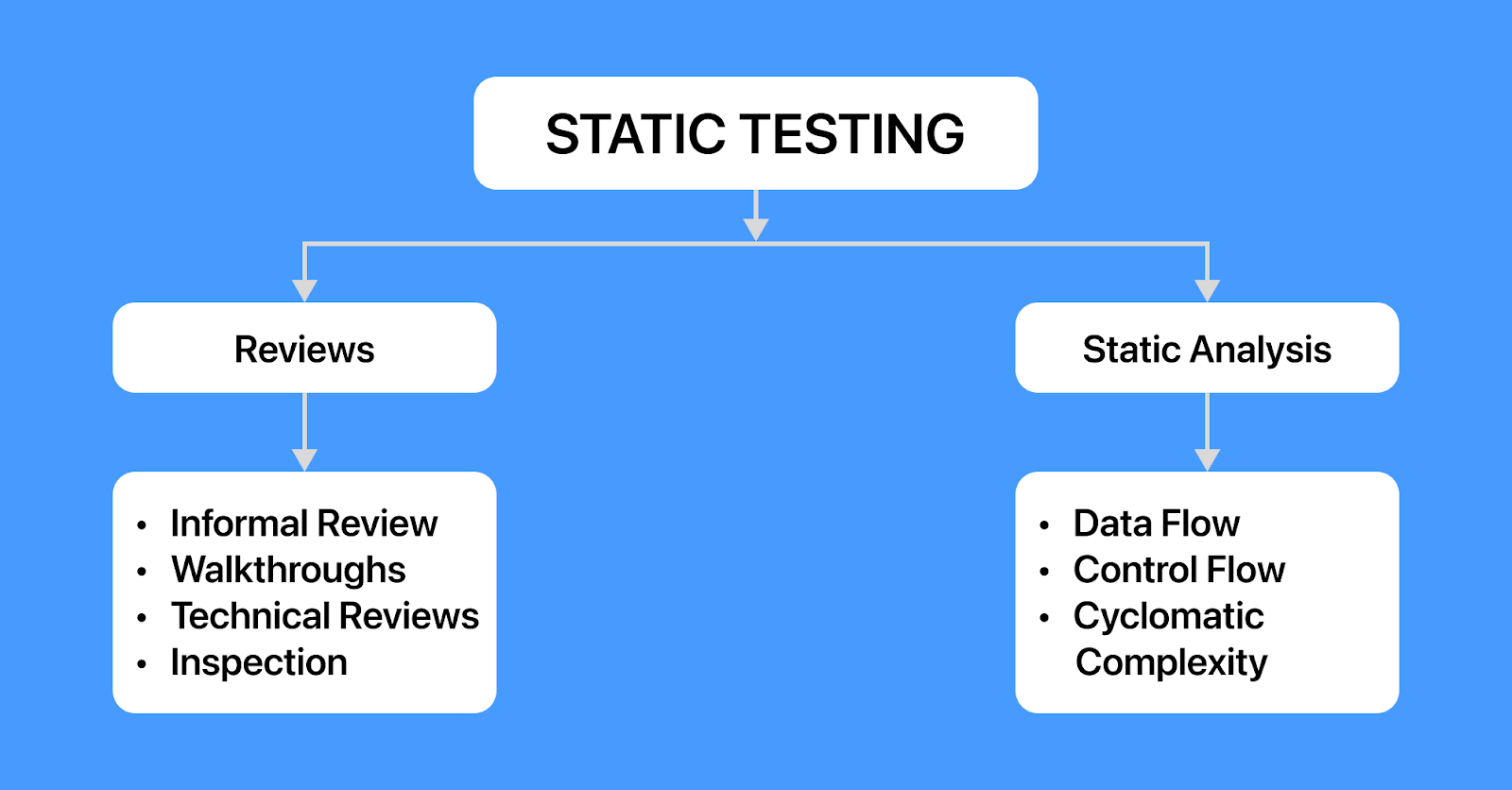
Reviews
Review is one of the most used techniques to execute static testing, which involves finding any potential error or issue in the design of the software application. Here, the Quality Analyst (QA) reviews the specification documents and other software application reports to check their alignment with the requirement. During the review, the most significant advantage it offers is that all the members of the software application development get to know about the application's progress, and any discrepancies are sorted out by addressing diverse thoughts and excellent suggestions.
You can execute a review by four different methods:
- Informal review
- Walkthrough
- Inspection
- Technical review
- Moderator: Responsible for entry checks, rework follow-up, team coaching, and meeting schedule.
- Author: Takes charge of addressing identified defects and enhancing document quality.
- Scribe: Logs defects during reviews and attends review meetings.
- Reviewer: Examines material for defects and conducts inspections.
- Manager: They oversee review execution, ensuring alignment with process objectives.
- Deviations from standards
- Non-maintainable code
- Design flaws
- Missing requirements
- Inconsistent interface specifications
Initiated during the early document stages, informal reviews involve a casual exchange between two individuals, which can later expand to include more participants. This process lacks a formal procedure and documentation yet significantly enhances the document's quality. Although various methods for formal testing exist, informal reviews are commonly preferred.
In the walkthrough, active participation from team members occurs, enabling collective feedback to establish a unified comprehension that serves the document's intent. Given the authors' preparedness for this review, it minimizes the need for a detailed study. All presented content requires evaluation, and proposed solutions warrant validation before the discussion.
The document under study undergoes assessment by its author and other individuals, demanding diverse opinions. Multiple feedback inputs are considered, facilitated by step-by-step explanations that aid participants in obtaining a lucid overview.
This process promotes a thorough examination of the code and document before the meeting, which enhances the overall quality of the document. This approach guarantees comprehensive coverage, minimizing the risk of overlooking requirement aspects. It also fosters mutual understanding among team members, facilitating the generation of alternative solutions or suggestions.
The most formal review type involves a senior or trained team member guiding the process. Before the meeting, reviewers and documents are prepared. Inspections comprehensively examine the entire product, identifying and logging defects. The focus lies on elevating document quality.
Inspection efficiently identifies defects, promotes high-quality documents, and prevents the recurrence of similar issues. Raised defects are recorded and discussed, with discussions carried forward once defects are resolved. By detecting problems early, inspection significantly enhances software quality.
In a formal meeting, technical reviews discuss the document's technical content, often guided by an expert. It ensures technical accuracy and consistency, benefiting from expert insights. The technical review aims to achieve an agreement on technical aspects across documents.
After documentation, experts carry out informal reviews that include architects, chief designers, key users, and peers. These reviews involve evaluating all technical concepts to ensure their appropriate application, specifically focusing on verifying the correct use of these concepts.
Within the review process, four distinct participant roles engage in testing:
Static testing excels in identifying specific types of defects, such as:
Commonly, defects uncovered during testing pertain to security vulnerabilities, undeclared variables, boundary violations, syntax errors, and inconsistent interfaces.
Static Analysis
Static Analysis involves assessing the quality of code authored by developers. Diverse tools are employed for code analysis, comparing it against established standards. This process helps in identifying defects such as
- Unused variables
- Dead code
- Infinite loops
- Variables with undefined values
- Incorrect syntax
Static Analysis encompasses three categories:
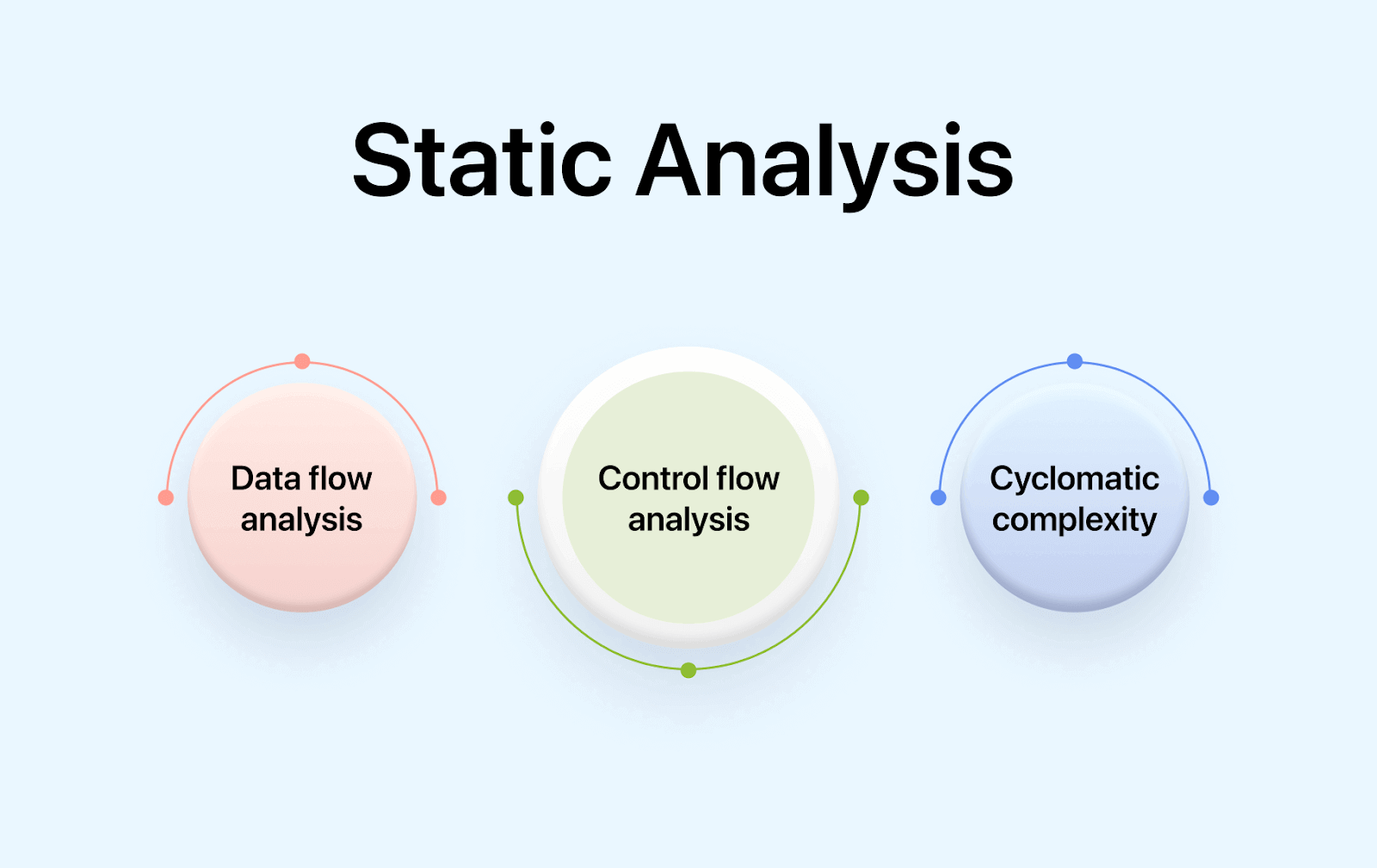
- Data flow analysis: It is an analytical approach related to stream processing evaluation. This method mainly evaluates the flow of information from one point to another, which includes operations, functions, and variables.
- Control flow analysis: It concerns how instructions within the software applications are executed. This approach inspects different approaches to processing the order of statements, branching mechanisms, and conditions. This helps you gain information on the logical structure of the programs and find the issues related to control flow, like unreachable code, unintended branching, and infinite loops.
- Cyclomatic complexity: Evaluates the number of independent paths in the control flow graph derived from code or flowcharts, aiding in designing optimal test cases for each independent path.
Static Testing Tools
Various tools are available in the realm of testing processes, and our attention now turns to discussing the most frequently employed ones.
CheckStyle
CheckStyle serves as a development tool aimed at aiding Java programmers in adhering to coding standards. It automates code assessment, ensuring alignment with established norms.
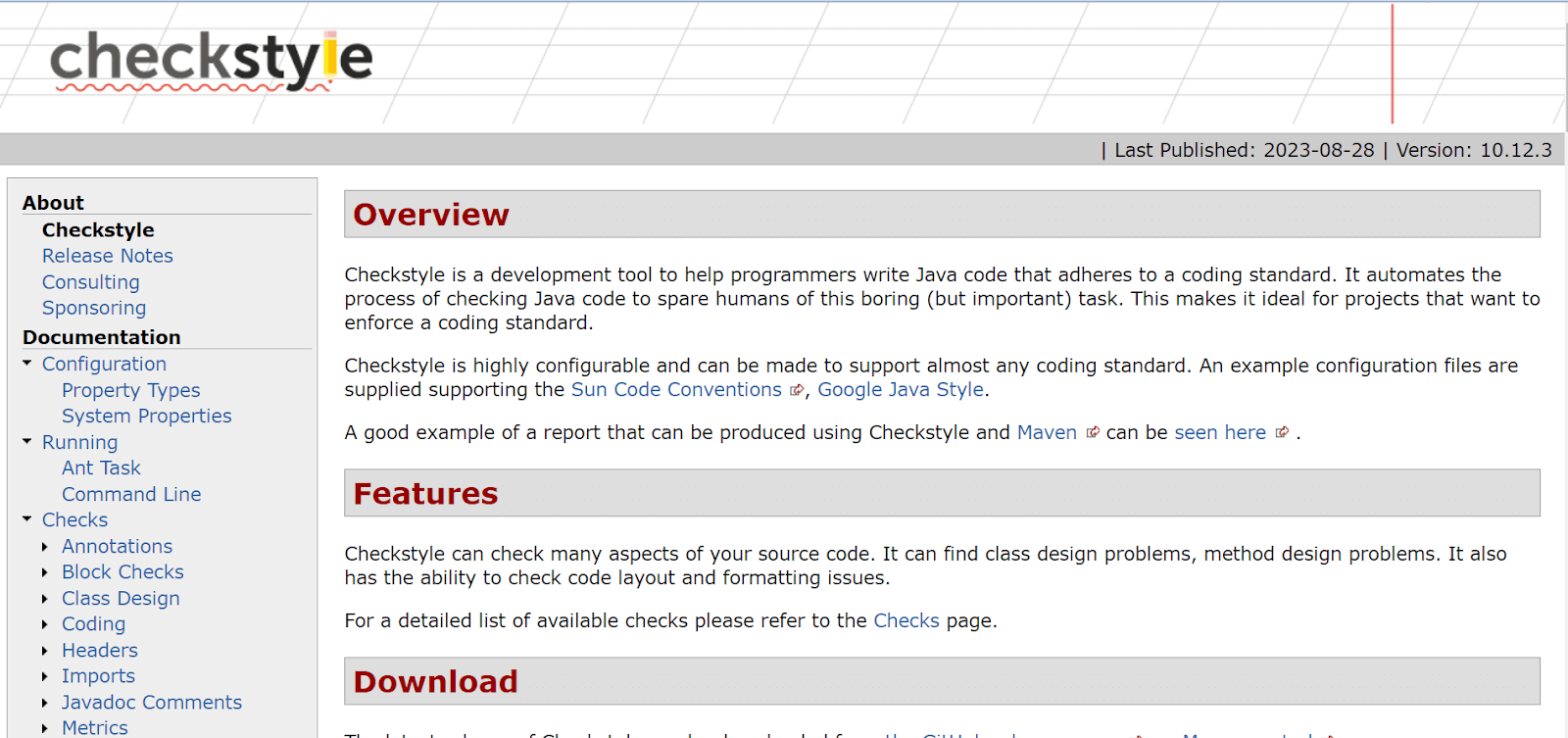
Key Features of CheckStyle:
- Highly adaptable tool supporting a wide range of coding standards.
- Supports configuration files like Google Java Style and Sun code conventions.
- Aids in verifying code layout, formatting, method design, and class design.
SourceMeter
SourceMeter excels as an advanced tool specializing in static source code analysis for various programming languages, including C/C++, C#, Java, Python, and RPG projects. It identifies vulnerabilities in developing systems by analyzing source code.
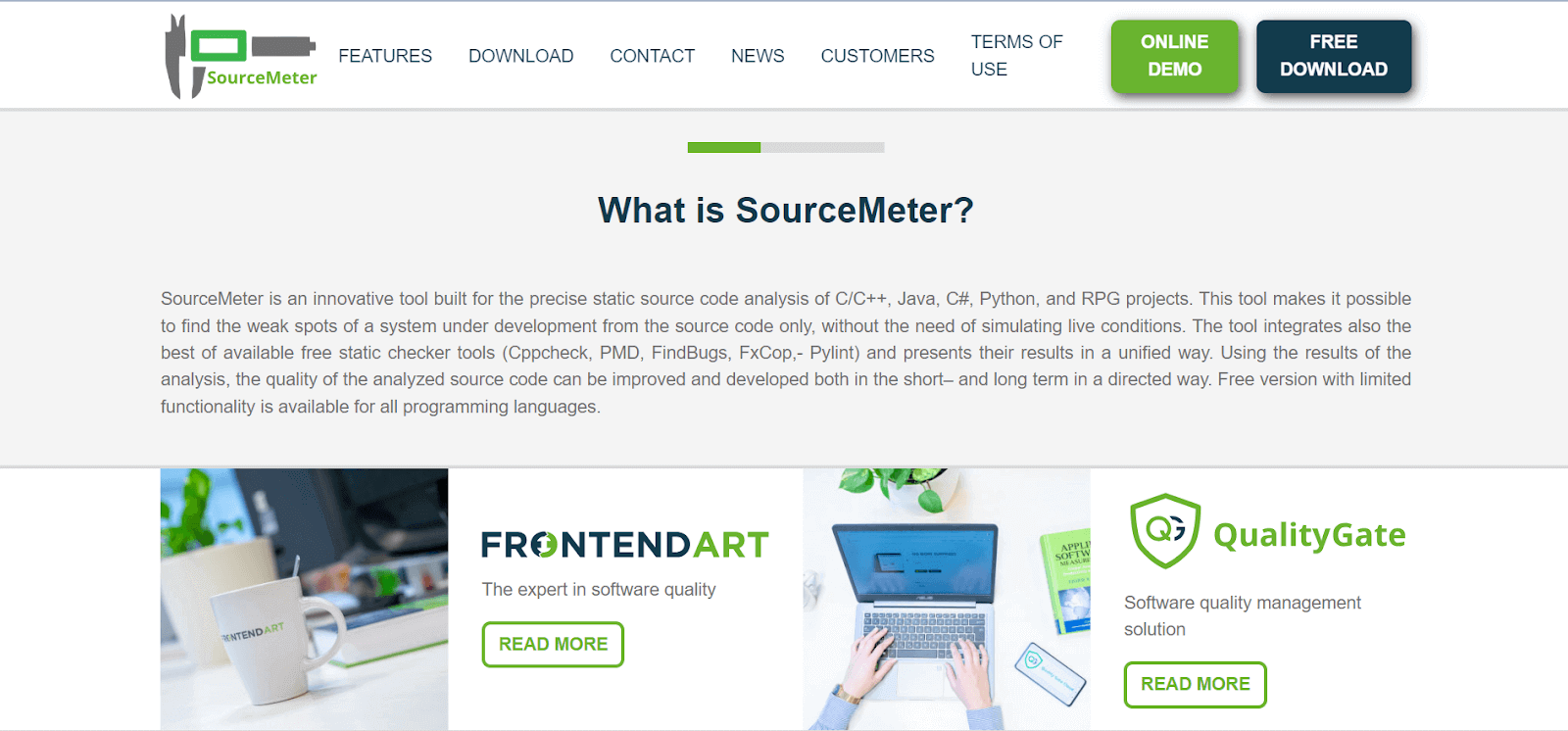
- Precise detection of coding errors.
- Facilitates deep static code analysis.
- Enhances user interface through third-party integration.
- Provides platform-independent command-line tools.
- Offers a free version with partial functionality for multiple programming languages.
Soot
Functions as a Java optimization framework, catering to the analysis and transformation of Java and Android applications.
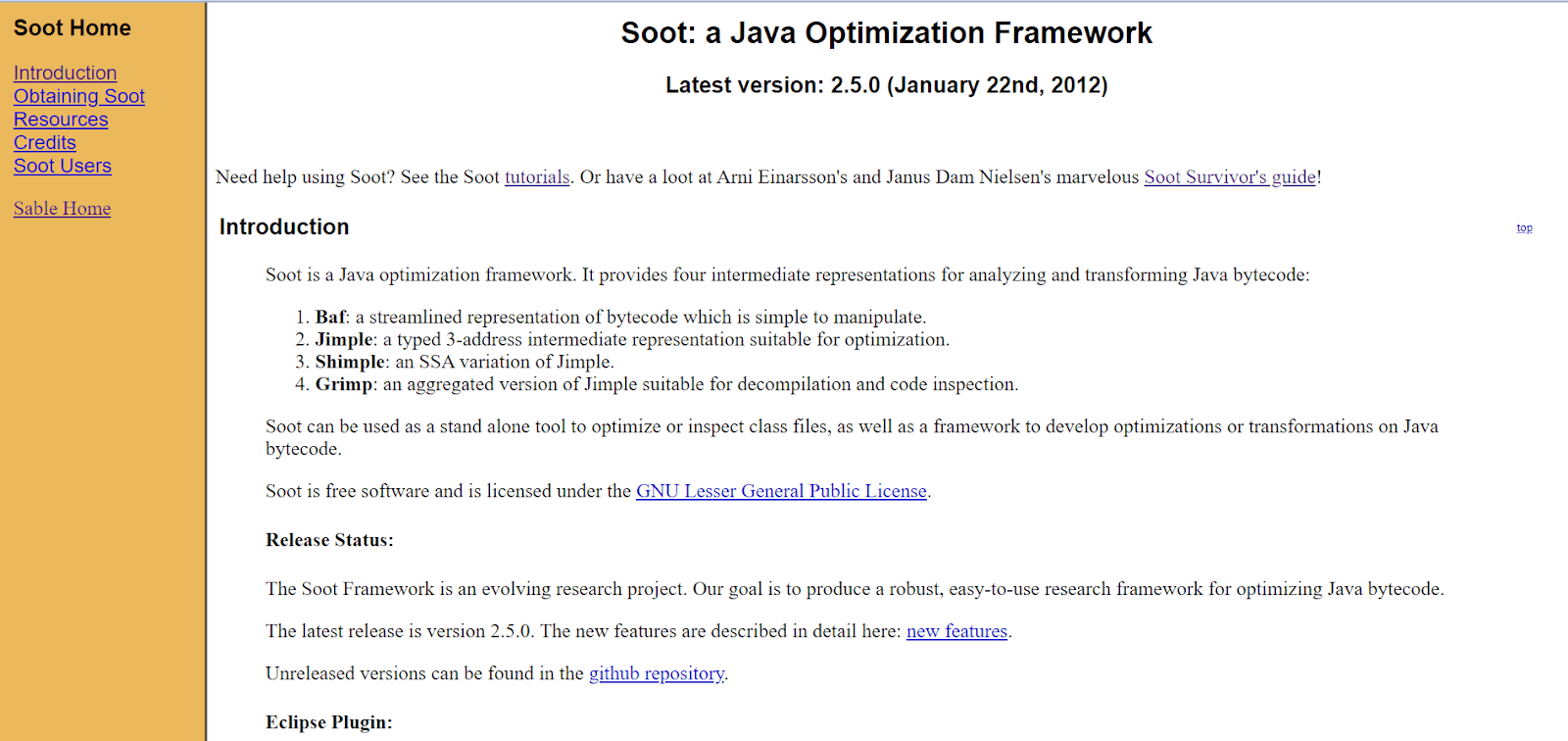
Key Features of Soot:
- It assesses aspects like named modules, modular jar files, automatic modules, exploded modules, and module resolution.
- Moreover, Soot generates potentially transformed code in formats like Android bytecode, Java bytecode Jasmin, and Jimple.
- These tools empower developers to enhance code quality, security, and adherence to best practices in the static testing domain.
Lint
Lint is a static analysis tool that scans code to highlight programming errors, bugs, and improper coding practices. Lint tools play a pivotal role in enforcing coding standards and preemptively detecting errors and bugs within code.
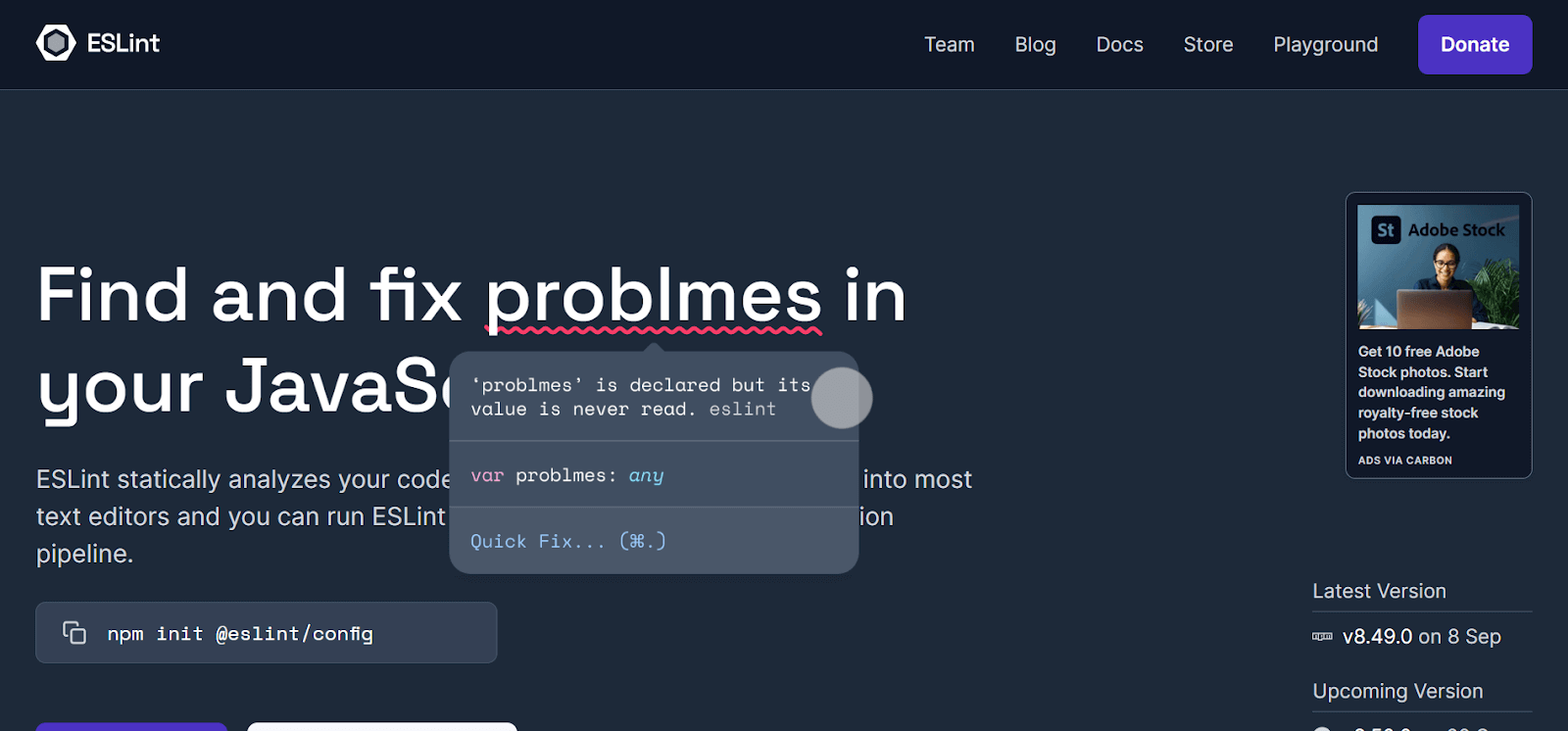
Key Features of Lint:
- A thorough code review for errors and irregularities.
- Enforces adherence to coding standards.
- Aids in preventing coding pitfalls and vulnerabilities.
SonarQube
SonarQube stands as an open-source platform for ongoing code quality inspection. It conducts static analysis and identifies technical debt, bugs, and vulnerabilities across various programming languages.
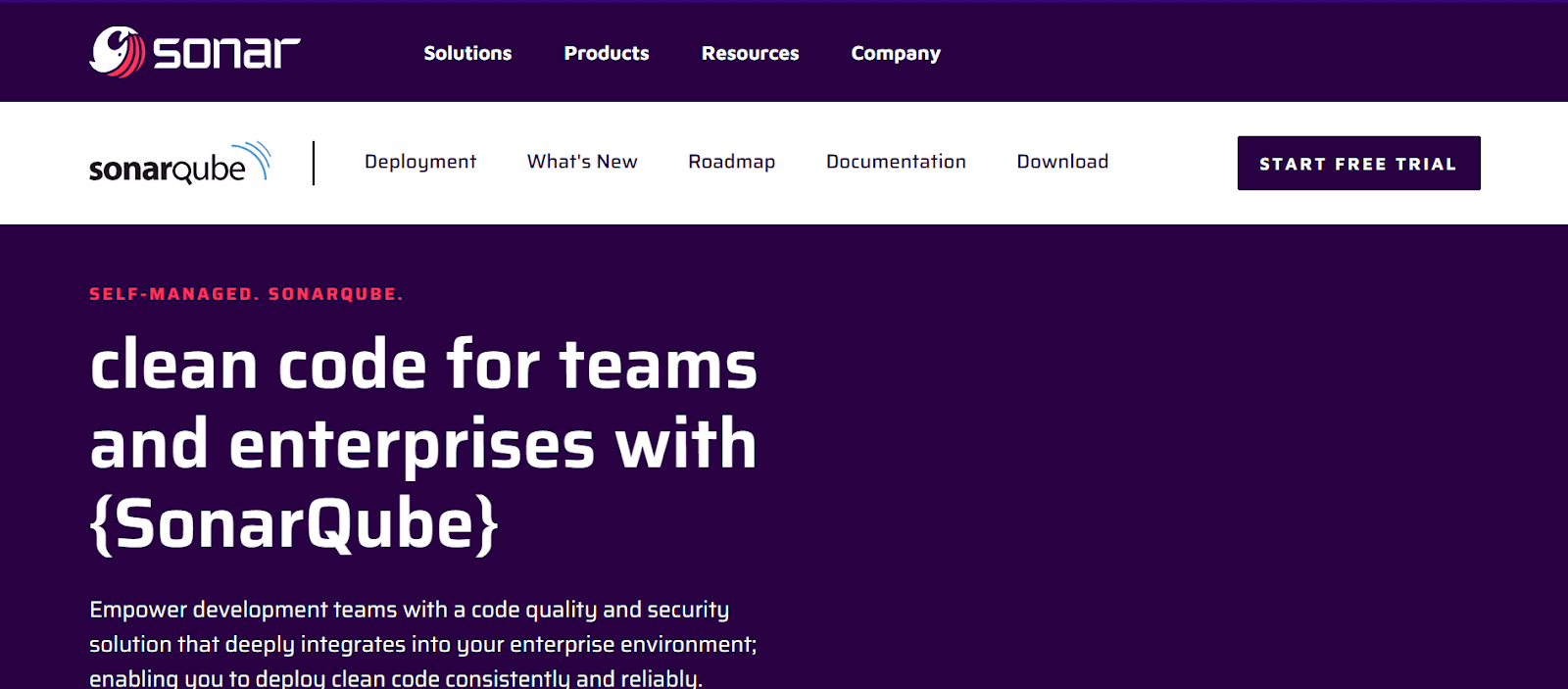
Key Features of SonarQube:
- Continuous evaluation of code quality.
- Proficient detection of technical debt, bugs, and vulnerabilities.
- Multi-language support for enhanced versatility.
After performing a critical review of the requirements and codes, you can proceed with software testing using automation testing tools. You can leverage the true capability of software testing with cloud-based platforms like LambdaTest.
LambdaTest is an AI-powered test orchestration and execution platform that enables you to perform manual and automation testing on a large scale. It excels in dynamic testing by facilitating real-time interaction with web applications across extensive arrays of browsers, operating systems, and devices. This seamless interaction allows for assessing software behavior and performance under diverse testing scenarios.
It seamlessly integrates with your testing requirements, offering various solutions tailored to your manual and automated testing needs. With LambdaTest, you can ensure comprehensive and efficient testing of software applications across various platforms and environments.
Example of Static Testing
Imagine a scenario where your development team diligently enhances a mobile app's login process. They focus on refining the user interface, enhancing security measures, and ensuring a smooth user experience. However, during their careful work, they unintentionally neglect a crucial aspect: including a password recovery option for users who may forget their login details.
Through a thorough review of the feature's design specifications, a tester can detect this potential oversight. Using testing techniques during the documentation review phase, the tester can catch this gap well before the feature progresses to the execution stage.
Finding this issue with static testing helps the team fix it early so users won't get stuck without a way to reset their passwords. In simple terms, It acts like an early warning system, ensuring important things like password reset are included, making the app better for users.
Best Practices of Static Testing Process
Consider these valuable pointers for a successful static testing procedure:
- Understand Objectives: Gain a clear understanding of the process goals. Develop a plan aligned with these objectives to ensure success.
- Formulate Strategy: Create a testing strategy that aligns with your goals. Utilize methods like code reviews, walkthroughs, and inspections for effective testing.
- Target Components: Identify the software application components that require testing for a comprehensive system evaluation and to meet their requirements.
- Review Effectiveness: Regularly evaluate the effectiveness of the process through periodic reviews to identify areas for improvement.
- Utilize Appropriate Tools: Choose the right tools for enhanced testing efficiency with static analysis, ensuring the accuracy of the process.
- Define Clear Procedures: Establish explicit and thorough testing protocols to maintain consistency in testing and reporting, capturing all relevant information.
- Ensure Communication: Set up a communication plan to share testing process information with teams involved in software development.
- Provide Training: Ensure that all individuals involved in testing receive adequate training, empowering them to perform efficient testing following established procedures.
- Monitor and Improve: Continuously monitor the testing process to refine practices and strategies.
- Document for Transparency: Use documentation to provide clear insights into the testing process, its progress, and the results achieved.
Conclusion
Static testing proves invaluable for early defect identification and obtaining a comprehensive understanding of documents. It helps uncover missing requirements, ambiguities, design flaws, and maintenance concerns. This assessment, primarily conducted by developers, proactively addresses technical issues. Experts scrutinize the code, catching problems before testing. Furthermore, this practice promotes the establishment of universally accepted code standards.
A document undergoes multiple evaluations, each tailored to specific objectives and procedures. Informal reviews precede more technical or formal assessments, addressing issues identified informally. Frequent reviews throughout development reduce the chances of late-stage defects.
However, this testing may primarily uncover simple errors, potentially missing some issues. To ensure the effectiveness of static testing, careful technique selection involving the right stakeholders and regular evaluations are essential.

2M+ Devs and QAs rely on LambdaTest
Deliver immersive digital experiences with Next-Generation Mobile Apps and Cross Browser Testing Cloud
On this page
- Overview
- What is Static Testing?
- Features of Static Testing
- Key Applications of Static Testing
- Key Aspects of Static Testing
- Advantages of Static Testing
- Disadvantages of Static Testing
- Static Testing vs. Dynamic Testing
- What is Tested in Static Testing?
- When is Static Testing Required?
- How to Perform Static Testing?
- Why Perform Static Testing?
- Static Testing Techniques
- Static Testing Tools
- Example of Static Testing
- Best Practices of Static Testing Process
- Conclusion
- Frequently Asked Questions
Frequently asked questions
- General
Author's Profile

Nazneen Ahmad
Nazneen Ahmad is an experienced technical writer with over five years of experience in the software development and testing field. As a freelancer, she has worked on various projects to create technical documentation, user manuals, training materials, and other SEO-optimized content in various domains, including IT, healthcare, finance, and education. You can also follow her on Twitter.
Reviewer's Profile

Saniya Gazala
Saniya Gazala, a Computer Science graduate, brings two years of hands-on experience in manual testing and delving into technical writing, showcasing her detail-oriented and systematic approach. As a technical reviewer, her key responsibilities involve spotting inconsistencies and factual errors in content. Leveraging her in-depth knowledge, she ensures the accuracy and coherence of the material under review.
Did you find this page helpful?
More Hubs
Try LambdaTest Now !!
Get 100 minutes of automation test minutes FREE!!

 Christmas Deal is on: Save 25% off on select annual plans for 1st year.
Christmas Deal is on: Save 25% off on select annual plans for 1st year.







